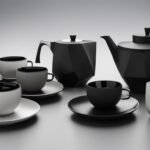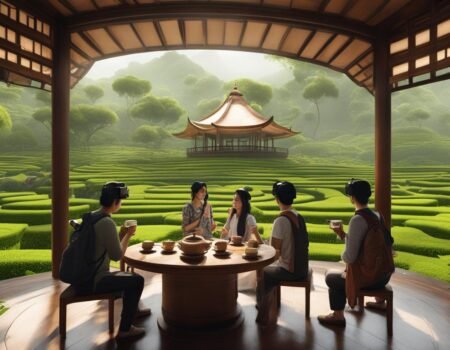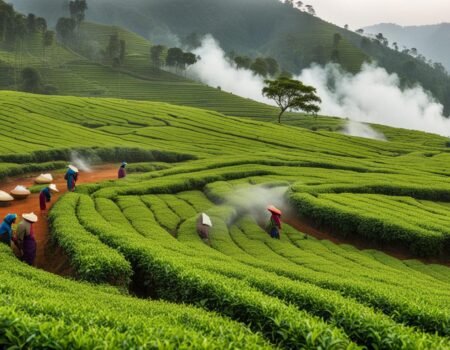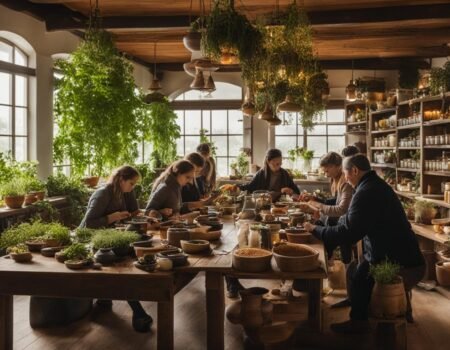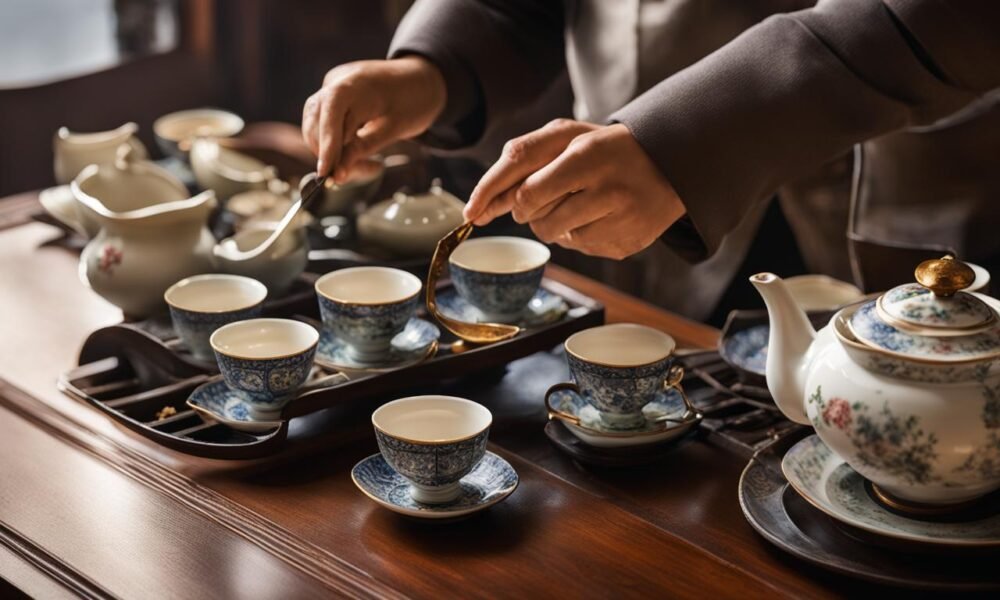
Discover the Elegance of the Chinese Tea Ceremony: A Cultural Journey
Welcome to our exploration of the captivating Chinese Tea Ceremony Tradition! In this article, we will delve into the history, customs, and intricate details of this age-old practice that embodies elegance, precision, and harmony. Join us on a cultural journey as we unravel the artistry and spirituality behind the Chinese Tea Ceremony.
The Chinese Tea Ceremony Tradition holds centuries of cherished history, rooted in ancient China. It is a ritual that honors tea, artistry, and spiritual connection. This meticulously choreographed tradition demands patience, focus, and an appreciation for the intricate details of tea preparation.
Key Takeaways:
- Chinese Tea Ceremony Tradition is a captivating embodiment of elegance, precision, and harmony.
- The ceremony involves meticulous tea preparation and demands patience and focus.
- It has a rich history rooted in ancient China.
- The Chinese Tea Ceremony Tradition celebrates tea, artistry, and spiritual connection.
- Join us on a cultural journey to unravel the artistry and spirituality of the Chinese Tea Ceremony.
The Art of Tea Brewing in the Chinese Tea Ceremony
The Chinese Tea Ceremony is an ancient tradition that embodies elegance, precision, and harmony. At the heart of this captivating ceremony is the art of tea brewing. Every step and technique involved in the brewing process contributes to the creation of a sensory experience that transcends the mere act of drinking tea.
Central to the Chinese Tea Ceremony is the selection of teaware, meticulously designed to enhance the flavors and aromas of the tea. Yixing clay teapots, known for their porous nature and ability to retain the essence of the tea, are a popular choice. Gongfu tea cups, on the other hand, are designed to bring out the nuances of the tea’s taste, aroma, and color, elevating the overall experience.
The brewing process itself is a delicate art form. The tea master carefully controls the temperature of the water and the steeping time to extract the tea’s full range of flavors. Each steeping reveals a different facet of the tea’s complexity, and the tea master adjusts the brewing parameters accordingly.
Throughout the ceremony, attention to detail is paramount. From the proper handling and pouring of the tea to the precise measurements and movements, every action is executed with intention and skill. The result is a perfectly brewed cup of tea that delights the senses and inspires a deep connection with the tradition and its rich history.
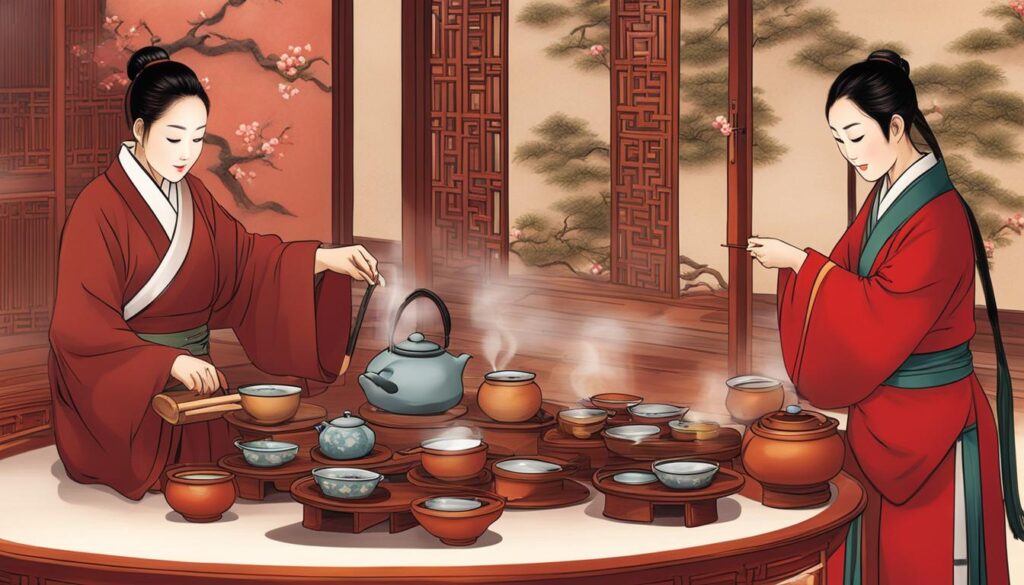
Chinese Tea Ceremony Brewing Steps
| Step | Description |
|---|---|
| 1 | Preheat the teaware by pouring hot water into the teapot, cups, and pitcher. Discard the water. |
| 2 | Place the tea leaves into the teapot, using the recommended amount based on the type of tea. |
| 3 | Pour hot water into the teapot, covering the tea leaves. Immediately pour the water out to rinse the leaves. |
| 4 | Refill the teapot with hot water, allowing the tea leaves to steep for the recommended time based on the type of tea. |
| 5 | Pour the tea into the pitcher, ensuring an even distribution of flavors. |
| 6 | Pour the tea into the cups, starting with a higher pour to distribute the flavors evenly and ending with a lower pour for a balanced taste. |
| 7 | Enjoy the tea, savoring its aroma, taste, and the moments of tranquility it brings. |
Symbolism and Spirituality in the Chinese Tea Ceremony
The Chinese Tea Ceremony is not just a mere act of brewing and drinking tea; it is a profound experience that embodies symbolism and spirituality. Every element of the ceremony holds significance, creating a deeper connection to nature, oneself, and others. The symbolic gestures and movements in the ceremony evoke a sense of reverence and mindfulness, elevating tea drinking to a sacred ritual.
One of the key symbols in the Chinese Tea Ceremony is the tea leaves themselves. The leaves represent a connection to nature, reminding us of the harmony and balance found in the natural world. The act of pouring tea is a symbol of respect and gratitude, reflecting the traditional Chinese values of humility and appreciation. It is believed that the precise movements and gestures performed during the ceremony help channel positive energy and create a peaceful atmosphere.
The Chinese Tea Ceremony is often accompanied by the Gongfu Tea Ceremony, which is characterized by its meticulous attention to detail and focus on the artistry of tea brewing. This traditional tea ceremony requires skill, patience, and precision. Each step, from the selection of teaware to the pouring of water, is performed with intention and mindfulness. The process of brewing tea becomes a meditative practice, allowing participants to cultivate a deeper sense of presence and awareness.
“The Chinese Tea Ceremony is a beautiful blend of art, culture, and spirituality. It offers a unique opportunity to slow down, appreciate the simplicity of life, and find solace in the serene moments.”
By partaking in the Chinese Tea Ceremony, individuals can embark on a transformative journey of self-discovery and connection. The ceremony invites us to savor the present moment, cherishing the beauty of each sip and the company of others. It serves as a gentle reminder to embrace the tranquility and mindfulness that tea drinking can bring, fostering a deeper appreciation for the art of tea and its ability to nourish the body, mind, and soul.
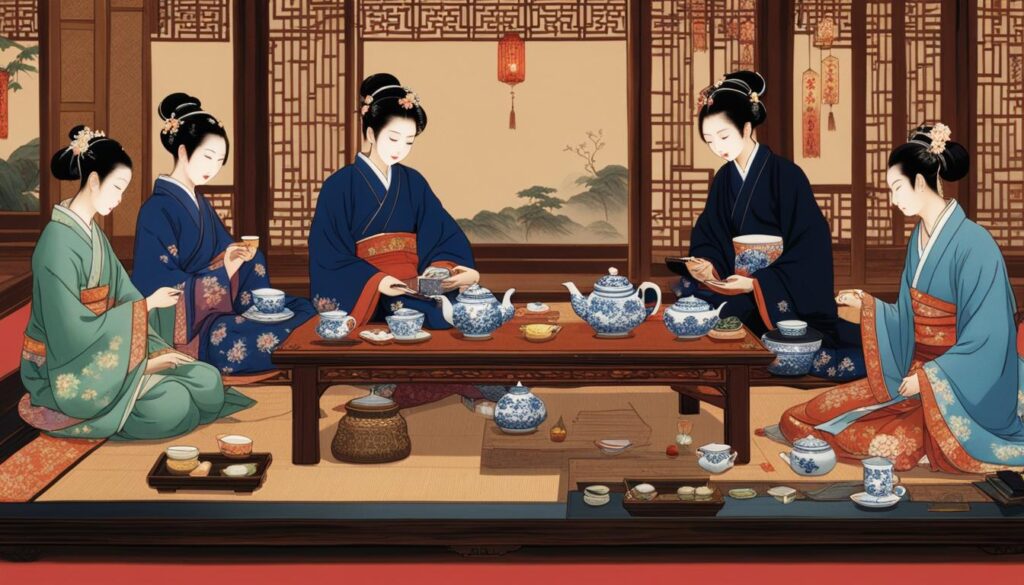
Symbolism in the Chinese Tea Ceremony
- The tea leaves represent a connection to nature.
- Pouring tea symbolizes respect and gratitude.
- Each gesture and movement carries meaning.
Spirituality in the Chinese Tea Ceremony
- The ceremony evokes a sense of reverence and mindfulness.
- Gongfu Tea Ceremony promotes presence and awareness.
The Social Aspect of the Chinese Tea Ceremony
The Chinese Tea Ceremony not only embodies elegance and spirituality but also serves as a social event that brings people together. Whether it’s a gathering with friends or a family gathering, the ceremony provides a unique opportunity for bonding, conversation, and creating lasting connections.
If you’re interested in learning and practicing the Chinese Tea Ceremony yourself, there are traditional classes available. These classes offer a deep dive into the customs, techniques, and symbolism associated with the ceremony. You’ll have the chance to learn from experienced tea masters who will guide you through the steps and help you develop a profound appreciation for the art form.
To fully immerse yourself in the Chinese Tea Ceremony experience, you can also invest in a Traditional Chinese Tea Ceremony kit. These kits typically include all the essential tools and utensils needed to perform the ceremony, such as a teapot, teacups, and a tea tray. By having your own kit, you can recreate the ceremony in the comfort of your own home and host your own tea gatherings.
For those seeking an authentic Chinese Tea Ceremony experience, Beijing offers specific venues that provide immersive experiences. These venues are often run by tea masters who have dedicated their lives to preserving and sharing the tradition. By participating in a ceremony in Beijing, you’ll have the opportunity to witness the intricate details of the ceremony firsthand and learn from the best in the field.
Conclusion
The Chinese Tea Ceremony Tradition is not just a mere tea-drinking experience; it is a cultural journey that encompasses mindfulness, precision, and harmony. From the intricate art of tea brewing to the rich symbolism and spirituality, this tradition offers a profound connection to nature and a deep appreciation for the finer details of tea preparation.
Whether you choose to participate in an organized ceremony or brew tea at home, the Chinese Tea Ceremony serves as a guide to slowing down and finding solace in serene moments. It is a reminder to appreciate simplicity and embrace the values that this ancient tradition represents.
For those seeking to delve further into this captivating tradition, the Chinese Gongfu Tea Ceremony offers a more immersive experience. In Beijing, there are venues where you can learn from experienced tea masters and explore the depths of this art form. Additionally, traditional classes and kits are available for those who wish to practice the ceremony in the comfort of their own homes.
So whether you’re sipping tea in a peaceful garden or gathering with loved ones, we invite you to embark on your own journey through the Chinese Tea Ceremony. Let it guide you towards a greater understanding of tea, mindfulness, and the beauty that lies in the art of brewing.
FAQ
What is the origin of the Chinese Tea Ceremony?
The Chinese Tea Ceremony originated in ancient China and has been cherished for centuries for its celebration of tea, artistry, and spiritual connection.
What is the significance of the teaware used in the Chinese Tea Ceremony?
Intricately designed teaware, such as Yixing clay teapots and Gongfu tea cups, are chosen to enhance the flavors and aromas of the tea.
How is the tea brewed in the Chinese Tea Ceremony?
The tea brewing process involves multiple steepings, with the tea master skillfully adjusting the brewing parameters to extract the tea’s nuanced flavors.
What is the symbolism behind the gestures and movements in the Chinese Tea Ceremony?
Each gesture and movement in the ceremony carries meaning, from the way the teapot is held to the direction of the pour, deepening the participants’ reverence and awareness.
Is the Chinese Tea Ceremony a social affair?
Yes, the Chinese Tea Ceremony often brings friends and family together, offering an opportunity for bonding, conversation, and deepening connections.
Can I learn and practice the Chinese Tea Ceremony myself?
Yes, there are traditional classes and kits available for those interested in learning and practicing the ceremony. In Beijing, specific venues offer immersive experiences with experienced tea masters.
What values does the Chinese Tea Ceremony showcase?
The Chinese Tea Ceremony showcases the values of mindfulness, precision, and harmony, allowing participants to appreciate the art of tea and its ability to nourish the body and soul.
How can I embrace the Chinese Tea Ceremony at home?
You can brew tea at home using the principles and techniques of the Chinese Tea Ceremony, allowing yourself to slow down, appreciate simplicity, and find solace in the serene moments.


